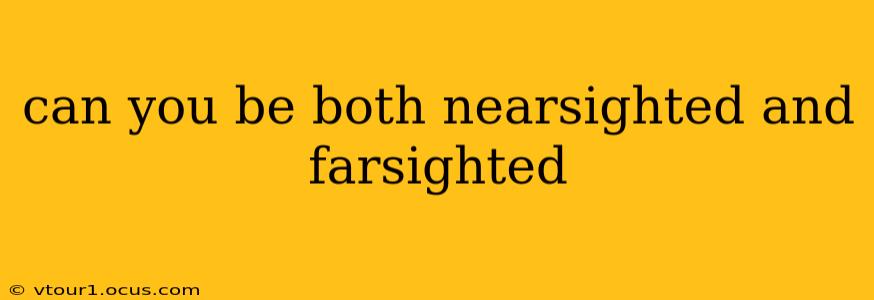Can You Be Both Nearsighted and Farsighted? Understanding Presbyopia and Other Eye Conditions
Yes, it's possible to be both nearsighted (myopia) and farsighted (hyperopia), though not simultaneously in the same way. The most common scenario involves a condition called presbyopia, which almost everyone experiences as they age. Let's break down how this works and explore other less common possibilities.
What is Nearsightedness (Myopia)?
Nearsightedness, or myopia, means you can see nearby objects clearly, but distant objects appear blurry. This is because the eyeball is slightly longer than normal, or the cornea (the front surface of the eye) is too curved, causing light to focus in front of the retina instead of directly on it.
What is Farsightedness (Hyperopia)?
Farsightedness, or hyperopia, is the opposite. You can see distant objects clearly, but nearby objects appear blurry. This happens because the eyeball is shorter than normal, or the cornea is too flat, causing light to focus behind the retina.
How Can You Be Both? The Role of Presbyopia
The most common way someone experiences both nearsightedness and farsightedness is through the natural aging process and the development of presbyopia. Presbyopia is the gradual loss of your eyes' ability to focus on nearby objects. It's not a disease, but a natural part of aging that typically begins in your 40s.
As you age, the lens inside your eye loses its flexibility, making it harder to change shape and focus on close-up objects. Someone who was nearsighted in their younger years might find that while they still need correction for distance vision (they remain myopic), they now also need reading glasses or bifocals to see things up close because of presbyopia. They are effectively experiencing both nearsightedness and farsightedness, albeit in different ways.
Can You Have Myopia and Hyperopia in Both Eyes Simultaneously?
It's extremely rare to have true myopia and hyperopia simultaneously within the same eye. The refractive error (the way light focuses in the eye) is usually consistent throughout the eye. However, it's possible to have myopia in one eye and hyperopia in the other, a condition called anisometropia. This is less common than simple myopia or hyperopia.
What About Other Eye Conditions?
While presbyopia is the most common reason someone might need correction for both near and far vision, other less frequent conditions could also contribute to this:
- Astigmatism: This condition causes blurry vision at all distances because the cornea or lens is irregularly shaped. Astigmatism can exist alongside myopia or hyperopia, further complicating the vision correction needed.
- Keratoconus: This is a progressive eye condition that causes the cornea to thin and bulge outward into a cone shape, leading to distorted vision that might require correction for both near and far distances.
When Should You See an Eye Doctor?
If you're experiencing blurry vision at any distance, it's crucial to consult an ophthalmologist or optometrist. They can perform a comprehensive eye exam to determine the precise nature of your vision problem and recommend the appropriate corrective lenses or other treatments. Regular eye exams are essential for detecting and managing any eye condition.
This information is for general knowledge and doesn't constitute medical advice. Always consult a healthcare professional for any health concerns.
